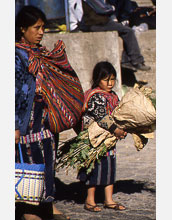Multimedia Gallery
Visualizing Social Science (Image 4)
"Guatemalan Mother and Child." This image was taken by photographer Rachel Tanur and was included in an exhibit of her work titled "Visualizing Social Science," that was shown at the National Science Foundation (NSF) headquarters in Arlington, Va., July thru October 2006, as part of The Art of Science Project. The Art of Science Project was conceived and implemented by a cross-directorate committee of NSF staff. Its purpose is to bring to NSF, original works of art that visually explore the connections between artistic and scientific expression.
The following excerpt, written by Hee-Choon Shin, NORC, University of Chicago, accompanied this photograph at the exhibit:
A daughter learns from her mother by following her footsteps, and sharing work, happiness and sorrow along the way. The family is the most important institution in a society. It is impossible for a human being to become a member of a society without family experiences. Socialization begins at home. We learn by imitating our mothers, fathers, grand parents, siblings, and other significant others. A little girl experiences the outside world by chasing her mother's shadow. In developing countries, a little girl is expected to help her mother. The little girl cleans, cooks, and raises smaller siblings. (Date of Image: 1998) [One of seven related images. See Next Image.]
More about this Photographer
During her short lifetime (1958-2002), Rachel Tanur traveled widely in the United States, China, Africa, Europe and Latin America, taking photographs that reflected not only her artistic flair and her training in architecture and urban design, but also her concern with people and their interactions.
Her photographs in this show, Visualizing Social Science, are accompanied by commentaries by social scientists from around the world. Many of the photos and commentaries reflect globalization and the resulting juxtaposition of traditional and modern artifacts and customs, often with ironic results. Others illustrate aspects of work--its ubiquity, its gender segregation, and its involvement of children. Many of the contributing female social scientists are struck, as was Rachel, with the beauty and incongruity of the public display of laundry hung out to dry; they layer fascination insights onto that beauty. Children and their socialization and the beauty and dignity of aging in traditional societies inspire comments, as do contrasts between pristine nature and environmental hazards posed by development.
More generally, Michael Kimmel writes, "Rachel makes a choice, reminding us of the simple dignity and even breathtaking beauty of the people over whom the economic machine runs in the march towards profits." And Daniel Rothenberg says of the photos and the photographer, "They express a direct, personal and emotional engagement with the lives of others while also conveying enough intellectual distance to be analytic. Their play between intimacy and commentary defines the photographer as someone bound to her subject, yet concerned with the larger implications of the images she records."
Credit: ©Estate of Rachel Tanur
Special Restrictions: This image is copyright and was included in the NSF Multimedia Gallery with permission. For personal use only.
Images and other media in the National Science Foundation Multimedia Gallery are available for use in print and electronic material by NSF employees, members of the media, university staff, teachers and the general public. All media in the gallery are intended for personal, educational and nonprofit/non-commercial use only.
Images credited to the National Science Foundation, a federal agency, are in the public domain. The images were created by employees of the United States Government as part of their official duties or prepared by contractors as "works for hire" for NSF. You may freely use NSF-credited images and, at your discretion, credit NSF with a "Courtesy: National Science Foundation" notation.
Additional information about general usage can be found in Conditions.
Also Available:
Download the high-resolution JPG version of the image. (183 KB)
Use your mouse to right-click (Mac users may need to Ctrl-click) the link above and choose the option that will save the file or target to your computer.



